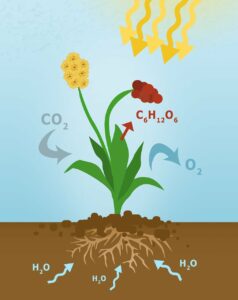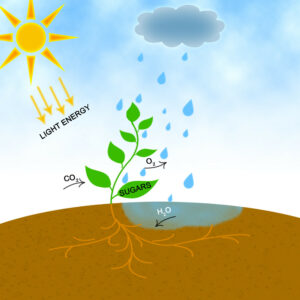Photosynthesis is an exclusive mechanism in which the photosynthetic organisms prepare their food for survival. They undergo complex processes and one of them is the light dependent reaction.
In this article, we will see the systemic reactions of the light dependent reaction example involved with respect to living beings
- Photosynthetic light dependent reaction or the Light dependent reaction of photosynthesis.
- The cyclic light dependent reaction of photosynthesis.
- The Non cyclic light dependent reaction of photosynthesis.
Before we enter into the process we need to know, what is the light dependent reaction?
The Light dependent reaction is the first or the primary stage of the photosynthesis in which the photosynthetic organism obtains the solar energy source or the light source from the sun, processes it and converts it into chemical energy and utilizes them as ATP-Adenosine triphosphate and NADPH- Nicotinamide Adenine Dinucleotide Phosphate for their survival.
The internal structures present inside the photosynthetic organisms aid in the conversion of the raw photosynthetic materials and produce the Adenosine triphosphate and Nicotinamide Adenine Dinucleotide Phosphate.

Image Credits- Wikimedia
The ATP or Adenosine triphosphate is the vital energy molecule.
The NADPH or the Nicotinamide Adenine Dinucleotide Phosphate is an electron donor to the organism which helps in the biosynthesis of all the cell components.

Image Credits- Pixabay
Read More on Why chromosomes are in pairs: comparative analysis on structure, function and facts.
What is the Light dependent reaction example?
Light dependent reaction is nothing but a reaction which happens with the presence of light that is the reaction depends on light- Sunlight.
The accurate light dependent reaction example is the process of photosynthesis which takes place in the region of the chloroplast called thylakoid .
This article completely focuses on the light dependent reaction example.
Read More on Difference between animal and plant cell chromosomes: Comparative analysis on structure, function and facts
Detailed explanation on Photosynthetic light dependent reaction example or the Light dependent reaction of photosynthesis:
- The aim of the light dependent reaction in photosynthesis is to trap the solar energy from the sunlight and break or convert the water molecule (H2O) into ATP-Adenosine triphosphate and NADPH- Nicotinamide Adenine Dinucleotide Phosphate.
- The ATP molecule –Adenosine triphosphate molecule and NADPH molecule- Nicotinamide Adenine Dinucleotide Phosphate molecule given out from the light dependent reaction process and is further utilized in the light independent reaction process.
- Chlorophyll is a pigment present inside the chloroplast. This pigment, chlorophyll absorbs the sunlight.
- The thylakoids in the chloroplast have few membranes called the thylakoid membranes which have a protein complex called the Photo System- I, Photo System- II.
- This chlorophyll that absorbs the sunlight is stored in these two protein complexes- Photo System- I, Photo System- II.
- When the sunlight falls on the region of the chloroplast that is present in the Photo System- II, the electrons get excited and travel towards the thylakoid membranes leaving the region of the chloroplast.
- The excited electrons travel along the thylakoid membranes along with the range of carrier proteins which are usually called the electron transport chain.
- The Photo system- II breaks the water molecule that is H2O splits to 2 hydrogen molecules and one oxygen molecule. The oxygen escapes as oxygen gas.
- The hydrogen ion gets flooded in the lumen of the thylakoid from the above process thus as they pass through the enzyme ATP synthase which give the final phosphate molecule to ADP(Adenosine diPhosphate) making it ATP- ATP-Adenosine triphosphate.
- Finally, the electron that comes from the photosystem II reaches to the photosystem I, which also has chlorophyll. The solar energy from the sun makes the electron excited again, providing enough energy to pass in between the membrane and towards the stroma.
- This combines with a hydrogen ion from the split up water molecule and an NADP+ to manufacture the energy holding molecule NADPH.
- ATP and NADPH then go towards stroma from the thylakoid, where the energy molecule is used to proceed with the process of the light-independent reactions.
Read More on Are Bacteria Prokaryotic Or Eukaryotic: Why, How And Detailed Insights And Facts

Image credits- Flickr
The image represents that the photosynthetic organisms procure the Carbon- di- oxide from air and water from the soil and utilize it for the photosynthesis.
Read More on Sequence Of Nitrogenous Bases In RNA: What, Why, Purpose, Detailed Facts
What is the cyclic light dependent reaction of photosynthesis?
The process by which the solar energy is trapped and transformed into a chemical energy so that the organisms utilize and survive is called photosynthesis.
The method that the photosynthesis process takes up can be cyclic or non cyclic. If it is cyclic phosphorylation, the flow of electrons will be in a unique manner that is they show up circular or a loop like flow and returns back to the Photosystem-1
So the vital ingredients or the elements required to perform the photosynthesis process are
- Carbon- di- oxide
- Water
- Sunlight
Only certain organisms will have the capacity to undergo this photosynthesis, they are called the photosynthetic organisms.
These photosynthetic organisms procure the Carbon- di- oxide from air and water from the soil and utilize it for the photosynthesis.
Read More on Is Cyanobacteria Unicellular Or Multicellular: Why, How And Detailed Insights
What is the Non cyclic light dependent reaction of photosynthesis?
In case of non cyclic phosphorylation it’s just the opposite of the cyclic phosphorylation one.
In non cyclic phosphorylation, the electrons excite and they do not return as both the photosystem (photosystem-1 and 2) are involved.
A Brief Account on what happens in the photosynthesis process:
- The process of photosynthesis looks very simple but it involves many complex mechanisms.
- The sunlight is utilized and the carbon- di- oxide in the air is trapped and gets converted to sugar (energy molecule).
- The sunlight is utilized and the water from the soil is converted to oxygen.
The photosynthesis equation:
6CO2 + 6H2O → C6H12O6 + 6O2
Summary of the light dependent reaction process:
- The ultimate goal is to convert the solar light energy to chemical energy.
- The light dependent reaction process will be performed in the thylakoid of the chloroplast organelle.
- The raw materials used is NADP+, Sunlight, H2O, ADP and the final products are NADPH, ATP, O2.
Also Read:
- Are bacteria autotrophs or heterotrophs
- Endocytosis molecular movement
- Eukaryotic fungi examples
- Single cell protein example
- Different types of pcr
- Do animal cells have cytoskeleton
- Bryophyte plant example
- Is cyanobacteria unicellular or multicellular
- Biennial plant example
- Scorpion examples

Hello, I am Sugaprabha Prasath, a Postgraduate in the field of Microbiology. I am an active member of the Indian association of applied microbiology (IAAM). I have research experience in preclinical (Zebrafish), bacterial enzymology, and nanotechnology. I have published 2 research articles in an International journal and a few more are yet to be published, 2 sequences were submitted to NCBI-GENBANK. I am good at clearly explaining the concepts in biology at both basic and advanced levels. My area of specialization is biotechnology, microbiology, enzymology, molecular biology, and pharmacovigilance. Apart from academics, I love gardening and being with plants and animals.
My LinkedIn profile-